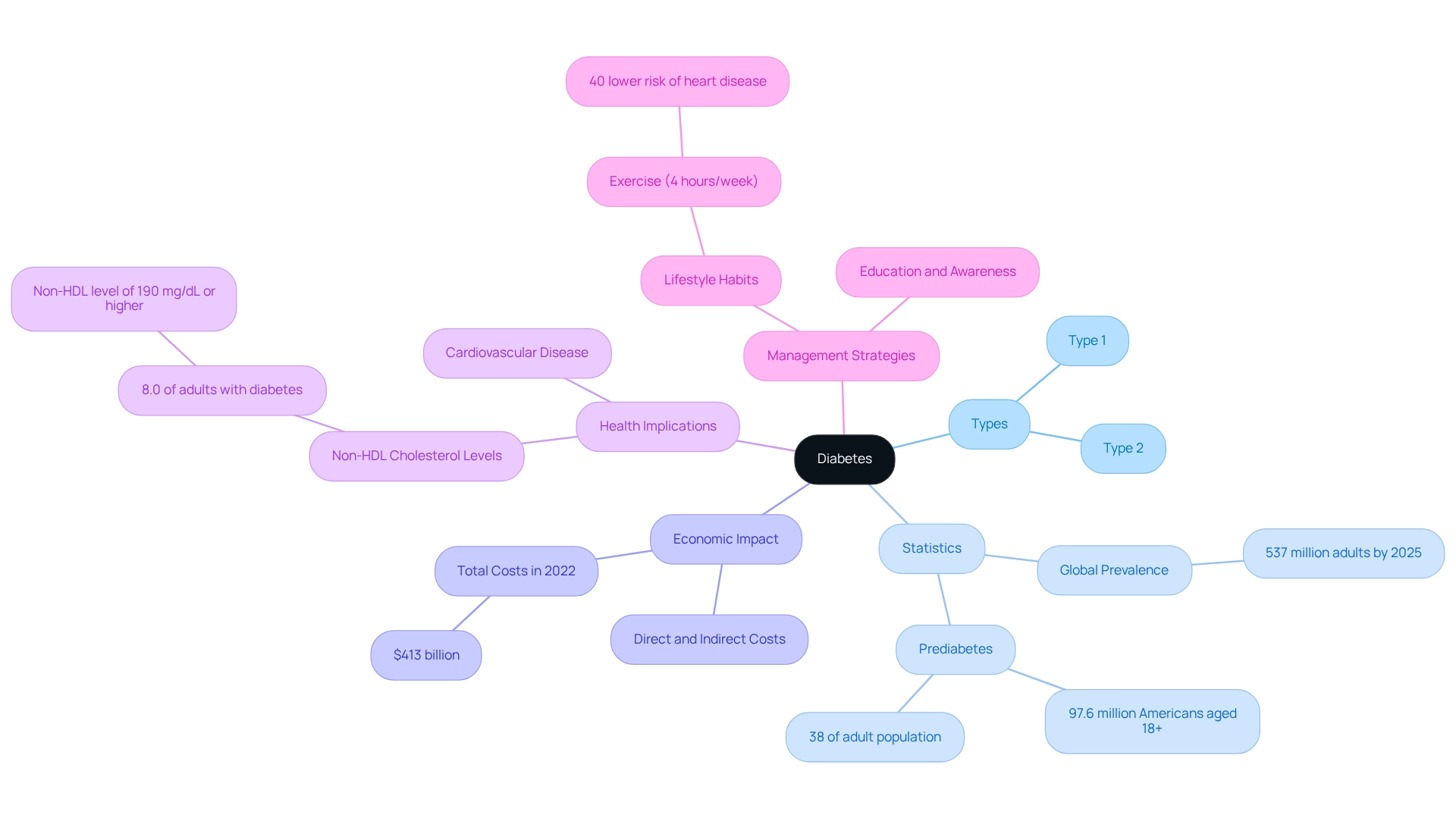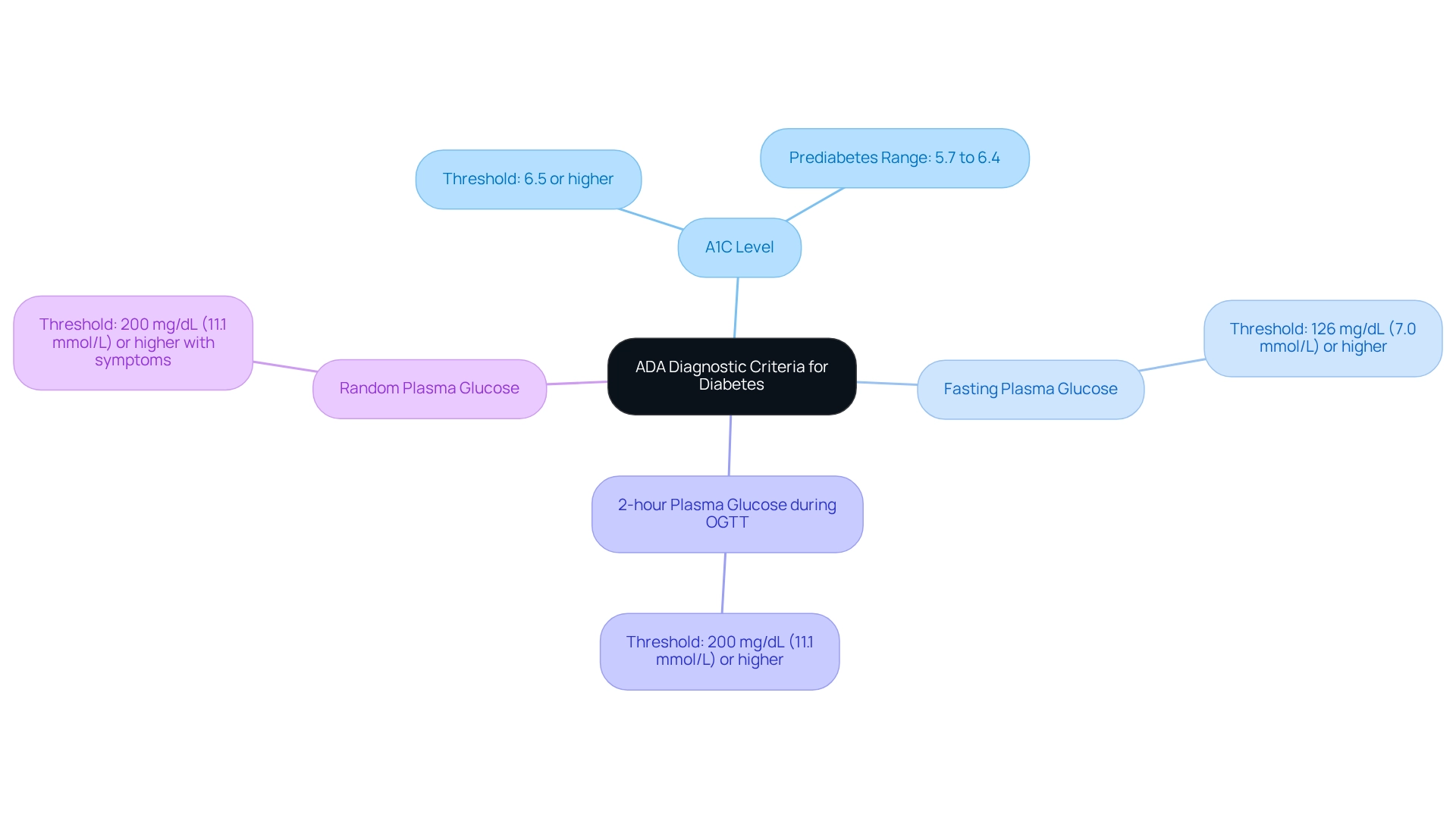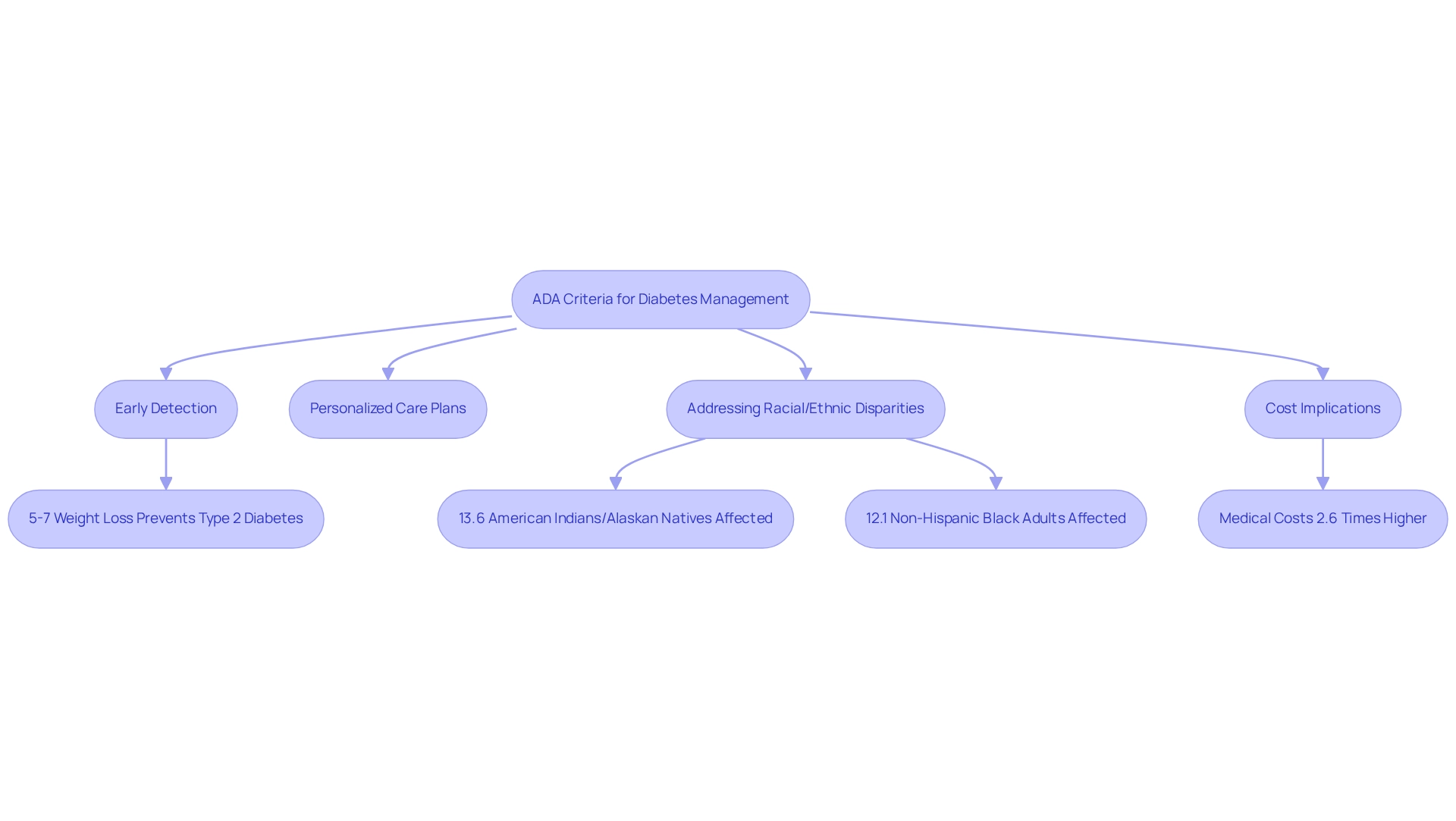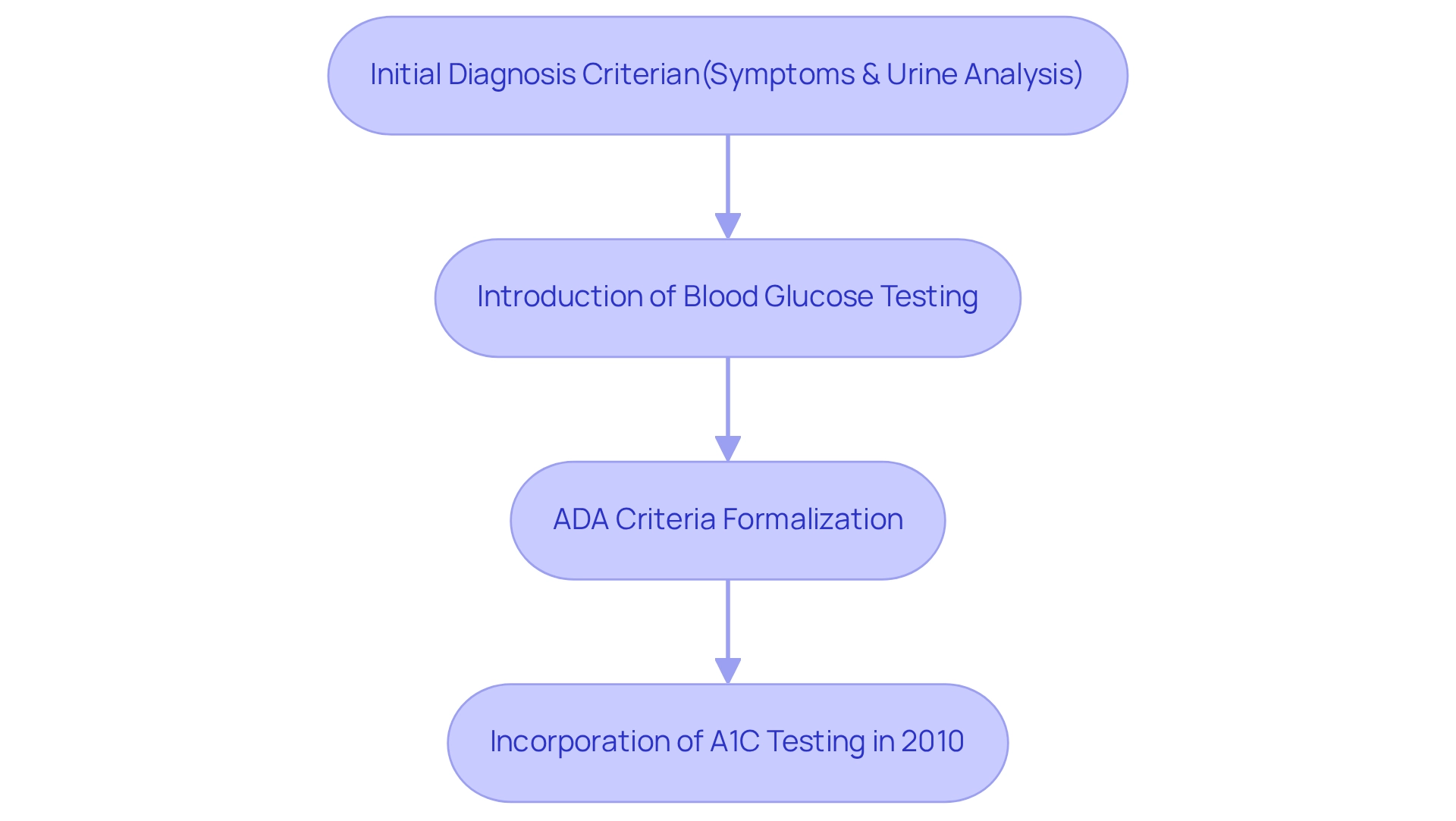Overview
The article highlights the American Diabetes Association (ADA) criteria for diagnosing diabetes, which includes specific blood glucose thresholds that are crucial for early detection and effective management of this condition.
It's understandable to feel overwhelmed by this information, but by establishing these standards, the ADA empowers healthcare providers to identify diabetes promptly.
This timely recognition allows for interventions that can significantly reduce the risk of complications and improve patient outcomes.
Remember, you’re not alone in this journey; there are resources and support available to help you every step of the way.
Introduction
Diabetes is more than just a medical condition; it represents a global health crisis that affects millions and demands our urgent attention. With an estimated 537 million adults living with diabetes as of 2025, understanding this chronic metabolic disorder is crucial for effective management and prevention of severe complications. The landscape of diabetes is complex, encompassing various types, economic burdens, and significant health implications. As the prevalence of prediabetes rises, it’s understandable to feel concerned about your health. Early detection becomes paramount, and established diagnostic criteria empower individuals to take charge of their well-being.
This article delves into the intricacies of diabetes, highlighting the significance of the American Diabetes Association's diagnostic standards. We will explore the historical evolution of these criteria, providing insights that are essential for newly diagnosed patients and healthcare providers alike. Remember, you're not alone in this journey; we are here to support you every step of the way.
Define Diabetes: Understanding the Condition
Diabetes is a chronic metabolic disorder that affects millions of people worldwide, characterized by elevated blood glucose levels due to issues with insulin secretion or action. It's understandable to feel concerned about this condition, as it can lead to serious health complications if not managed effectively. There are two main types:
- Type 1, an autoimmune disorder where the body cannot produce insulin
- Type 2, which is more common and often linked to insulin resistance
As we look to 2025, it's estimated that around 537 million adults globally are living with diabetes, highlighting the urgent need for effective management strategies.
The impact of diabetes extends beyond individual health; it also poses significant economic challenges. In 2022, the estimated costs associated with diagnosed diabetes-related health issues in the United States reached a staggering $413 billion. This figure reflects both direct medical expenses and the indirect costs of lost productivity, underscoring the importance of robust prevention and management programs to alleviate the financial burden on individuals and the healthcare system.
Recent studies show that adopting healthy habits can help prevent or delay the onset of prediabetes and Type 2 diabetes. For instance, women with diabetes who engaged in at least four hours of exercise each week saw a remarkable 40% reduction in their risk of developing heart disease compared to those who were inactive. Furthermore, the Centers for Disease Control and Prevention estimates that about 97.6 million Americans aged 18 and older have prediabetes, which accounts for approximately 38% of the adult population. This statistic emphasizes the critical need for effective management strategies to address the rising prevalence of prediabetes and its potential progression to Type 2 diabetes.
Understanding diabetes is vital, as it affects millions and requires ongoing management to prevent complications like cardiovascular disease, nerve damage, and kidney failure. The latest research continues to explore the complexities of blood sugar disorders and their related complications, reinforcing the importance of education and awareness in managing this chronic condition. Additionally, it's significant to note that 8.0% of adults with diagnosed diabetes had a non-HDL cholesterol level of 190 mg/dL or higher, further illustrating the health implications associated with the illness. At T2DSolutions, we are dedicated to providing newly diagnosed individuals with the tools and support they need to manage their condition successfully. Our platform offers educational materials, community support, and guidance on healthy lifestyle choices, empowering individuals on their journey toward better health. You are not by yourself on this path; we will assist you at every turn.

Outline ADA Diagnostic Criteria for Diabetes
The American Diabetes Association (ADA) establishes ADA criteria for diagnosis of diabetes, which are vital for early detection and effective management. These criteria include:
- An A1C level of 6.5% or higher
- A fasting plasma glucose (FPG) of 126 mg/dL (7.0 mmol/L) or higher
- A 2-hour plasma glucose level of 200 mg/dL (11.1 mmol/L) or higher during an Oral Glucose Tolerance Test (OGTT)
- A random plasma glucose level of 200 mg/dL (11.1 mmol/L) or higher in a patient exhibiting classic symptoms of hyperglycemia
It's important to note that according to the latest ADA criteria for diagnosis of diabetes in 2025, these diagnostic thresholds remain essential in detecting diabetes-related conditions. This enables healthcare providers to initiate timely interventions. You're not alone in this journey; the proportion of diabetes diagnoses according to the ADA criteria for diagnosis of diabetes continues to rise, indicating an increasing prevalence of the condition.
For instance, the occurrence of diabetic ketoacidosis at diagnosis among youth with type 1 diabetes has significantly risen from 1998 to 2013. This highlights the necessity for careful screening practices to detect the illness early. Experts emphasize that an A1C result between 5.7% and 6.4% indicates prediabetes. The American Diabetes Association states, "Your hemoglobin A1c result is 5.7% to 6.4%." This underscores the importance of monitoring and making lifestyle changes to prevent the progression to diabetes-related conditions.
As the global burden of diabetes escalates, comprehensive public health strategies, including education and enhanced access to healthcare resources, are essential in addressing this crisis. We are here to support you every step of the way. T2DSolutions strives to be a valuable resource for newly diagnosed patients, offering educational materials and community support to help you navigate your condition and manage your health effectively.

Discuss Importance of ADA Criteria in Diabetes Management
At T2DSolutions, we recognize the vital role of the ADA criteria for diagnosis of diabetes in effectively managing diabetes. These standards provide a framework for early identification, which is crucial. Early detection allows for timely intervention, significantly reducing the risk of complications such as neuropathy, retinopathy, and cardiovascular diseases. Did you know that losing just 5 to 7% of body weight through exercise and nutritious eating can prevent the onset of type 2 diabetes? This statistic highlights the importance of early detection in making meaningful lifestyle changes.
The ADA criteria for diagnosis of diabetes also empower healthcare providers to create personalized care plans that cater to each patient's unique needs. This tailored approach not only enhances treatment outcomes but also encourages individuals to take an active role in managing their health. For instance, case studies reveal that racial and ethnic disparities exist in the prevalence of diabetes-related conditions, requiring targeted health initiatives. The rates of diagnosed blood sugar disorders differ significantly among racial and ethnic groups, with:
- 13.6% of American Indians/Alaskan Natives affected
- 12.1% of non-Hispanic Black adults affected
These disparities underscore the necessity for culturally sensitive management strategies that address the specific challenges faced by diverse communities.
In 2025, reports indicated that the average medical costs for individuals diagnosed with diabetes are 2.6 times greater than for those without the condition. This statistic reinforces the economic necessity for early identification and intervention (Centers for Disease Control and Prevention). Diabetes educators consistently advocate for the ADA criteria for diagnosis of diabetes, emphasizing their role in enhancing outcomes through improved education and self-management practices. As one educator shared, the ADA criteria for diagnosis of diabetes not only guide assessment but also empower patients to engage actively in their care, resulting in better health outcomes.
By following these guidelines, healthcare professionals can significantly improve the quality of life for individuals living with diabetes, ultimately leading to better health outcomes and fewer complications. At T2DSolutions, we are committed to supporting this effort by providing resources and education that highlight the importance of early detection and proactive management. Remember, early detection is crucial—statistics show that delayed identification can lead to serious complications, emphasizing the need for proactive screening and intervention. You're not alone in this journey, and we are here to support you every step of the way.

Trace Historical Development of Diabetes Diagnosis Standards
The criteria for identifying diabetes have changed significantly over time, and understanding this background is essential for those recently diagnosed seeking guidance from T2DSolutions. Initially, assessment relied heavily on visible symptoms and urine analysis. The term 'diabetes' itself comes from the Greek word for 'siphon,' reflecting the frequent urination that is typical of the condition. However, the early 20th century brought a pivotal shift with the introduction of blood glucose testing, allowing for more accurate assessments of glucose levels in patients.
By the late 20th century, the American Diabetes Association (ADA) began to formalize the ADA criteria for diagnosis of diabetes, culminating in the incorporation of A1C testing in 2010 as a critical tool for diagnosis. This evolution has been driven by a growing understanding of diabetes and the recognition of the need for early detection and effective management. It's understandable to feel concerned, especially as global cases of diabetes have increased four-fold over the past decades, highlighting the necessity for improved diagnostic standards.
Historical case studies illustrate the profound impact that blood glucose testing has had on diagnostic accuracy, leading to better patient outcomes. The rigorous methodology used for data gathering and analysis in these studies ensures high-quality and consistent information across research. This enables robust conclusions regarding the relationship between glycemic biomarkers and the prevalence of diabetes. Additionally, specialists emphasize the importance of adjusting the ADA criteria for diagnosis of diabetes to reflect current research and regional differences in disease prevalence, ensuring that public health approaches remain effective. As Charles “Chuck” Henderson, the CEO of the ADA, stated, "Enhancing the lives of individuals impacted by this condition is a key part of the ADA’s mission," which underscores the significance of these evolving standards.
As T2DSolutions launches as a resource hub for health education, it aims to provide newly diagnosed individuals with the knowledge and tools necessary to navigate their diagnosis and care effectively. The continuous refinement of diagnostic standards is essential for addressing the complexities of diabetes management in today's healthcare landscape. Remember, you are not alone in this journey; T2DSolutions is committed to supporting you every step of the way.

Conclusion
Understanding diabetes is crucial for both individuals and healthcare professionals, especially as this condition affects millions globally. It's important to acknowledge the complexities of diabetes, including its various types, economic burdens, and significant health implications. With nearly 537 million adults diagnosed with diabetes as of 2025, the urgency for effective management strategies cannot be overstated. Early detection, facilitated by the American Diabetes Association's diagnostic criteria, plays a vital role in preventing severe complications and improving patient outcomes.
The ADA's criteria not only guide healthcare providers in diagnosing diabetes but also empower patients to take control of their health. By recognizing the importance of early diagnosis and tailored management plans, individuals can implement lifestyle changes that significantly reduce their risk of developing complications associated with diabetes. Moreover, the historical evolution of these diagnostic standards illustrates the ongoing efforts to refine our understanding of diabetes, ensuring that public health strategies remain effective in addressing this growing crisis.
In conclusion, the fight against diabetes requires a collective effort to raise awareness, promote education, and ensure access to healthcare resources. As the prevalence of diabetes continues to rise, initiatives like T2DSolutions are essential in providing support and guidance for those navigating their diabetes management journey. Remember, you're not alone in this journey. By fostering a proactive approach to prevention and treatment, individuals can improve their quality of life and reduce the economic burdens associated with this chronic condition.
Frequently Asked Questions
What is diabetes?
Diabetes is a chronic metabolic disorder characterized by elevated blood glucose levels due to issues with insulin secretion or action.
What are the two main types of diabetes?
The two main types of diabetes are Type 1, which is an autoimmune disorder where the body cannot produce insulin, and Type 2, which is more common and often linked to insulin resistance.
How many adults are estimated to be living with diabetes by 2025?
It is estimated that around 537 million adults globally will be living with diabetes by 2025.
What are the economic impacts of diabetes in the United States?
In 2022, the estimated costs associated with diagnosed diabetes-related health issues in the United States reached approximately $413 billion, reflecting both direct medical expenses and indirect costs of lost productivity.
How can healthy habits impact the onset of diabetes?
Adopting healthy habits, such as engaging in regular exercise, can help prevent or delay the onset of prediabetes and Type 2 diabetes. For instance, women with diabetes who exercised at least four hours a week saw a 40% reduction in their risk of developing heart disease.
What percentage of the adult population in the U.S. has prediabetes?
Approximately 38% of the adult population in the U.S., or about 97.6 million Americans aged 18 and older, have prediabetes.
Why is understanding diabetes important?
Understanding diabetes is vital because it affects millions of people and requires ongoing management to prevent complications such as cardiovascular disease, nerve damage, and kidney failure.
What resources does T2DSolutions provide for newly diagnosed individuals?
T2DSolutions provides educational materials, community support, and guidance on healthy lifestyle choices to help newly diagnosed individuals manage their condition successfully.



